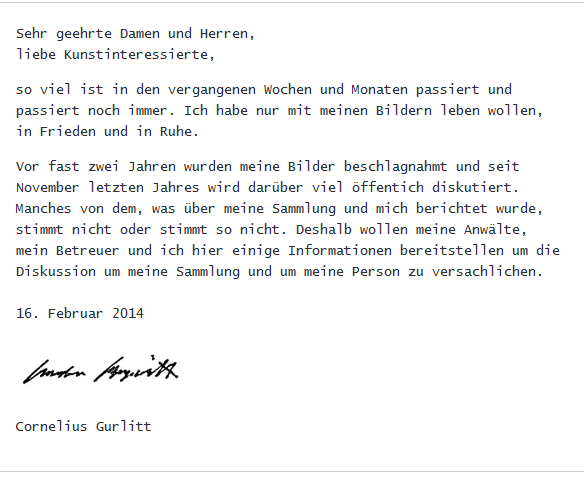Art World
Munich Art Trove: More Works, a New Law, and a Web-based Response by Gurlitt


Alexander Forbes

Three months after reports broke of a substantial collection of Nazi-looted art being discovered in the Munich apartment of octogenarian Cornelius Gurlitt, yet more works have been recovered from his residence, this time in Salzburg. More than 60 works were removed from Gurlitt’s second home at his request for their own security. They are currently being examined for any possible links to Nazi loot independent from those in the original find. Pieces by Monet, Manet, Renoir, and others count among this latest set of works, according to the AFP. Further reports noted a higher concentration of paintings in this latest group of artworks and thus, presumably, a higher marginal value, compared to the initial 1,280 taken from Gurlitt’s Schwabing apartment in late February of 2012. Of those in the first group, only 96 are paintings, according to information published last November in German newspaper Die Zeit.
The Salzburg recovery effort has generated renewed interest in the case, with representatives from the Conference on Jewish Material Claims Against Germany demanding online publication of all of the most recently discovered works. The move would be in line with the previous publication of 458 pieces from the Munich trove on lostart.de. However, speaking with artnet News via mobile phone on Monday afternoon, Gurlitt’s spokesperson, Stephan Holzinger, said that no decision had been made as to whether they would allow publication of images and details of the works recovered.
According to Holzinger, a Munich-based lawyer who specializes in crisis and reputation management, all further updates about the Gurlitt case, including the works from Salzburg, will be announced through a newly created website, gurlitt.info, which serves to advocate for Mr. Gurlitt’s position in the affair. Commenting on the choice to create a comprehensive web portal for his client, Mr. Holzinger said: “I came aboard about ten days ago as spokesman for Mr. Gurlitt and have seen in many other cases of mine that coming up with a dispute website helps to get the facts right.” He went on to note that his office has received over 450 media requests since the removal of works from Gurlitt’s Salzburg residence alone. Due to the high volume of requests, as well as their international nature, he felt that an open online environment was necessary for the exchange of factual information and open dialogue, including claims from potential heirs to works within the collection that have already been published.
In a type-written and signed statement dated February 16, 2014, and posted on the website in German, Gurlitt returns to a plea, which he formerly voiced in the only interview he has consented to since the artworks were discovered: “I only wish to live with my pictures in peace and quiet.” He goes on to criticize alleged factual inaccuracies in reports about his collection and himself that have come out over the past months.
The website additionally features a timeline of major events in the case, a background on Cornelius Gurlitt’s father, Hildebrandt Gurlitt, explaining how he came into possession of the works, a 29-question FAQ, and a section dedicated to legal frameworks and background applicable to Nazi loot and Gurlitt’s professed ownership of the collection. On the site, Gurlitt and his legal aids claim that despite around 380 works having been deemed degenerate art, 290 of which were from museum collections, “at most 3% [or 35] of the works in the collection are genuinely suspected of being loot.” Elsewhere on the site, however, he does claim to be open to reasonable offers by museums who wish to purchase works they previously owned, which is something several museums have expressed interest in to Gurlitt’s lawyers. Gurlitt’s representatives are still in the process of fully translating the website into English. However, most of the information is already present.
Claims for more extensive efforts on behalf of the German government to enable the return of Nazi loot to its pre-war owners have continued to ring out, however. Principle among these efforts is a law drafted by Bavarian Justice Minister Winfried Bausback, and presented to German Parliament’s upper house last Friday. Under current law, there is a 30-year statute of limitations on attempts to retrieve stolen property. This includes Nazi-looted art and other valuables. Bausback’s proposal, which has been dubbed the “Lex Gurlitt,” removes that temporal limitation on claims. However, criticism has arisen that the law still requires plaintiffs to demonstrate that there was malicious intent in the acquisition of the goods. The Bavarian segment of the Green party has meanwhile advocated for Germany to adopt a similar set of laws as those passed in Austria in 1998. That statute requires museums to verify that every acquisition since 1933 does not have a Nazi provenance.